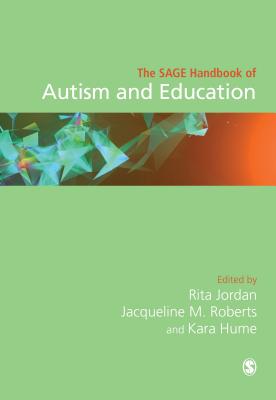图书简介
Education is an important aspect of the environmental influences on autism and effective education can have a significant effect on outcome for those on the autism spectrum. This handbook is a definitive resource for reflective practitioners and researchers who wish to know and understand current views of the nature of autism and best practice in educational support. It explores the key concepts, debates and research areas in the field.
Editors’ IntroductionRita Jordan \\ Part I: Learning Needs and Educational Responses \\ Chapter 1: Difference versus Disability: Implications of Characterisation of Autism for Education & SupportDamian Milton \\ Chapter 2: Particular Learning Needs of Individuals on the Autism SpectrumRita Jordan \\ Chapter 3: The History of Autism EducationAdam Feinstein \\ Chapter 4: Educational Structures: an International PerspectiveRita Jordan \\ Chapter 5: Systems and Politics of ProvisionSuzanne Carrington and Beth Saggers \\ Chapter 6: Professional Development for those Working in Education with Students on the Autism SpectrumGlenys Jones \\ Chapter 7a: Analysis of What Makes a Successful Professional in AutismHilde De Clercq \\ Chapter 7b: What Makes a Good Professional in Autism? A Parent’s PerspectiveMaureen Bennie \\ Chapter 7c: What Makes a Successful Professional in Autism? School Education – A Lived ExperienceJeanette Purkis \\ Part II: Early Intervention, Education in Core Domains and Family Support \\ Chapter 8: Early InterventionJacqueline Roberts and Kate Simpson \\ Chapter 9: Approaches to Early Intervention for Children with Autism and Their FamiliesLaura J. Hall and Samuel L. Odom \\ Chapter 10: Building on Early Foundations into School: Fostering Socialization in Meaningful Socio-Cultural ContextsLakshmi Balasubramanian, Alexander Mario Blum and Pamela Wolfberg \\ Chapter 11: Building on Early Foundations into School: Communication and LanguageGreg Pasco \\ Chapter 12: Thinking and LearningHeather MacKenzie \\ Chapter 13: Focus on FamiliesMichaela DuBay, Sallie Nowell, Linda R. Watson \\ Chapter 14: Transitions in the Early YearsConnie Wong \\ Part III: School-Based and Academic Education: Access & Support \\ Chapter 15: Curriculum Balance: Access to Academic Learning and the Therapeutic CurriculumWhitney Griffin, Kara Hume, and Ann M. Sam \\ Chapter 16: Learning Supports for Students on the Autism SpectrumAnn M. Sam and Kara Hume \\ Chapter 17: Individuals with Autism Spectrum Disorder and Skills for LivingNancy Bagatell \\ Chapter 18: Fostering Peer Relationships and Shared Learning for Students with Autism Spectrum DisordersHeartley B. Huber and Erik W. Carter \\ Chapter 19: Developing an Adaptive Behavior Curriculum across the Age and Ability RangeMichelle Lee, Kathryn Schweers & Rachel Loftin \\ Chapter 20: Language & LiteracyChristi Carnahan and Pamela Williamson \\ Chapter 21: Accessing a Broad and Relevant CurriculumEmily C. Bouck & Jordan Shurr \\ Chapter 22a: A Curriculum to Support Students with Autism and Special Talents and AbilitiesTrevor Clark \\ Chapter 22b: A Curriculum for the Dual Disability of Autism & Severe Intellectual DisabilityPrithvi Perepa \\ Part IV: Collaborative Working in Education \\ Chapter 23: Autism, Health and Education: Models and Systems for Working TogetherTamara May, Charmaine Bernie, Suzy Marty, Rebecca Sutherland, Jacqueline Roberts and Katrina Williams \\ Chapter 24: Autism Health and Education: Professional Roles and ChallengesCharmaine Bernie, Rebecca Sutherland, Katrina Williams, Suzy Marty, Tamara May and Jacqueline Roberts \\ Chapter 25: Fostering Collaborative Family-School Relationships to Support Students on the Autism SpectrumRozanna Lilley \\ Chapter 26: Building Capacity in Education SystemsJacqueline Roberts \\ Chapter 27: Educator Involvement in Research & EvaluationJessica Suhrheinrich, Sasha Zeedyk, Sarah Vejnoska and Aubyn Stahmer \\ Chapter 28a: Evidence-Based Practices with Apps Directed at Core AutismGerardo Herrera and Patricia Pérez-Fuster \\ Chapter 28b: Information and Communication Technologies as Educational SupportsSusan Hedges and Sue Fletcher-Watson \\ Part V: Education for Life and Barriers to Education \\ Chapter 29: Supporting Students in Postsecondary EducationElizabeth Evans Getzel, Seb M. Prohn and Staci Carr \\ Chapter 30: Anxiety and Mental Health – Implications for EducationTony Attwood \\ Chapter 31: Behavioural Issues and SupportsAndrew A. McDonnell, Michael McCreadie and Paul Dickinson \\ Chapter 32: Bullying Issues for Students on the Autism Spectrum and their FamiliesVerity Bottroff, Barbara Spears & Phillip Slee \\ Chapter 33: Overcoming Barriers to Educational Opportunities Post SchoolAndrea McLeod \\ Chapter 34a: Autism and Comorbidities: Autism Plus. Implications for Diagnosis, Prognosis and InterventionsChristopher Gillberg \\ Chapter 34b: Practical Effects of Co-morbidities and the Concept of NeurodiversityRita Jordan \\ Chapter 35a: Sexual Development and Gender Identity in AutismWenn Lawson \\ Chapter 35b: Cultural Issues in Education for those with AutismJorge Benavides-Rawson and Roy Richard Grinker \\ Chapter 36: Supportive Environments for Best Autism PracticeJim Taylor \\ Part VI: Data Collection in Education and Measurement of Progress \\ Chapter 37: Setting and Evaluating Goals in EducationKobe Vanroy and Peter Vermeulen \\ Chapter 38a: Feedback from Family Members on Outcomes and Experiences of Education for Individuals on the Autism SpectrumMaureen Bennie \\ Chapter 38b: Measuring Success from School Stakeholders’ PerspectivesJordan McNeil and Elizabeth O’Toole \\ Chapter 38c: Feedback from Individuals on the Autism Spectrum about the Experience & Outcome of EducationEmma Goodall \\ Chapter 39: Measuring Quality in Educational Programs for Students with Autism Spectrum DisorderSuzanne Kucharczyk and Peggy Schaefer Whitby \\ Chapter 40: Data Collection in Education and Measurement of ProgressLisa Ruble, Wing Hang Wong, & John McGrew \\ Chapter 41: Research in Autism Education: Current Issues and Future DirectionsBrian A. Boyd, Jessica R. Dykstra Steinbrenner, Stephanie S. Reszka and Abigail Carroll \\ Chapter 42a: Tiers of Education: the Power of Collaborative Partnership in the Creation and Delivery of Professional Development for Autism PractitionersKaren Guldberg \\ Chapter 42b: Crystal GazingRita Jordan
Trade Policy 买家须知
- 关于产品:
- ● 正版保障:本网站隶属于中国国际图书贸易集团公司,确保所有图书都是100%正版。
- ● 环保纸张:进口图书大多使用的都是环保轻型张,颜色偏黄,重量比较轻。
- ● 毛边版:即书翻页的地方,故意做成了参差不齐的样子,一般为精装版,更具收藏价值。
关于退换货:- 由于预订产品的特殊性,采购订单正式发订后,买方不得无故取消全部或部分产品的订购。
- 由于进口图书的特殊性,发生以下情况的,请直接拒收货物,由快递返回:
- ● 外包装破损/发错货/少发货/图书外观破损/图书配件不全(例如:光盘等)
并请在工作日通过电话400-008-1110联系我们。
- 签收后,如发生以下情况,请在签收后的5个工作日内联系客服办理退换货:
- ● 缺页/错页/错印/脱线
关于发货时间:- 一般情况下:
- ●【现货】 下单后48小时内由北京(库房)发出快递。
- ●【预订】【预售】下单后国外发货,到货时间预计5-8周左右,店铺默认中通快递,如需顺丰快递邮费到付。
- ● 需要开具发票的客户,发货时间可能在上述基础上再延后1-2个工作日(紧急发票需求,请联系010-68433105/3213);
- ● 如遇其他特殊原因,对发货时间有影响的,我们会第一时间在网站公告,敬请留意。
关于到货时间:- 由于进口图书入境入库后,都是委托第三方快递发货,所以我们只能保证在规定时间内发出,但无法为您保证确切的到货时间。
- ● 主要城市一般2-4天
- ● 偏远地区一般4-7天
关于接听咨询电话的时间:- 010-68433105/3213正常接听咨询电话的时间为:周一至周五上午8:30~下午5:00,周六、日及法定节假日休息,将无法接听来电,敬请谅解。
- 其它时间您也可以通过邮件联系我们:customer@readgo.cn,工作日会优先处理。
关于快递:- ● 已付款订单:主要由中通、宅急送负责派送,订单进度查询请拨打010-68433105/3213。
本书暂无推荐
本书暂无推荐















